Ron Ludekens
Betula / Birch - What Kind?
Question: My Landscaper planted a tree for me. The red tag on it just reads Betula Birch.
Is there any easy way for me to tell which Bertula this is ?
Thank You
Thomas M. - Levittown, NY
Answer: Easiest way is to ask your landscaper. (Obviously it did not come from us or else it would have had a tag with the full identity on it.) Otherwise you get to play detective and probably wait for the tree to be several years old to see its true characteristics. You will be looking for:
What color is the bark (Tan, white, bright white)? Does the bark exfoliate (shed or peel)? How tall is the tree? Does it weep a little or a lot? These true characteristics will not show up in a juvenile tree.
Then you compare your findings with published literature or drag your favorite local nurseryman down for a visit if he/she knows his/her trees. Or have your local college horticulture teacher put it on the next test for the students .
.
Most of the information can be found in your local library or as a Google search. When using Google, chose photos from a repsponsible source such as well respected universities or nurseries - not just someone who posted a photo and might have mis-named it.
Good luck.
Ron Ludekens 9-6-2011
Flame Mimosa - Fan Silk Albizia
Yesterday, I was driving down one of our county back roads near the nursery and saw this rather stunning sight:
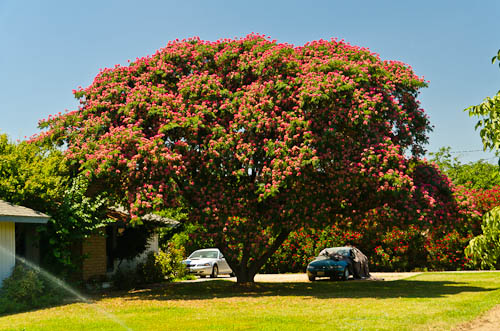
(Of course the photo would be a little nicer without the junker car under it and the rain-bird sprinkler running in the foreground.)
By the red flowers, it must be the Flame Mimosa (Albizia julibrissin 'Fan Silk') - or at least that is the same color of the flowers on the Fan Silk trees we grow. I have always found this to be a very attractive tree and I highly recommend the 'Fan Silk' over the paler pink seedling selection for the beauty of the red blooms.
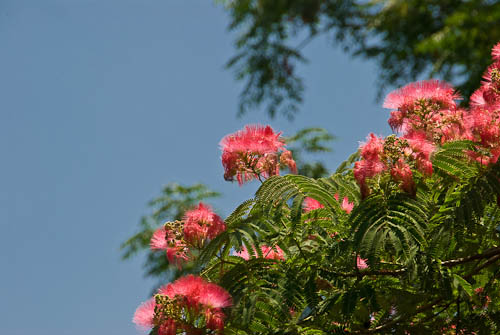
Red flowers of Albizia julibrissin 'Fan-Silk' (Flame Mimosa)
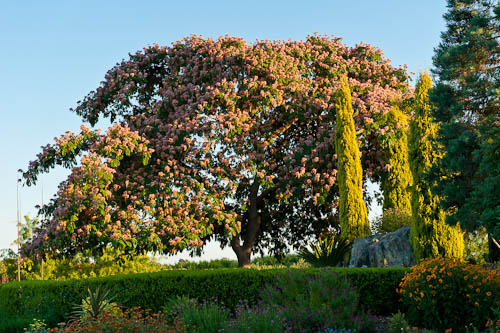
Comparison to seedling Albizia with pink flowers
Albizia are one of those trees that people love or hate. The negatives include abundant flower mess (but anything that blooms a lot will do this) and legume seed pods in the fall which can sprout in the landscape. You can see some of the flower fall on the lawn in the top photo.
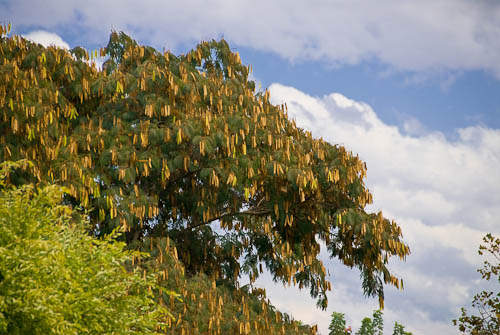
Seed pods in the fall look nice on the tree but will create some mess
People that like them (like me) point to the beauty of the blooms in early summer and the tropical-like, soft foliage. In the right places, these can be stunning landscape trees.
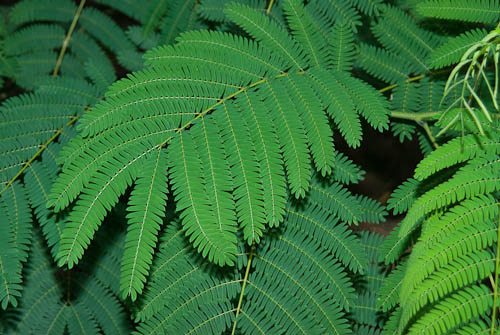
Soft tropical foliage
They are also very drought tolerant. For 30+ years we observed several Albizia growing wild in the open field of an abandoned prune drying facility. Outside of the 9" or so of annual rainfall in November through February, they were never watered. This is desert climate and they thrived while totally neglected.
I wonder where this family got their Albizia? You will notice that it is multi-branched and I kind of like it. We only offer the Fan Silk as a single trunk and a higher head although the pink seedlings we offer does have a multi-trunk option. I wonder if a chance seed from our Fan Silk was deposited by a bird and mowed off a few times in the lawn? Or a broken tree from our winter cull pile. Either way, need to inquire with our customers if this form is something wanted in the future.
More Albizia photos can be seen here: Albizia Photo Gallery
Ron Ludekens 7-15-2011
Persian & Black Beauty Fruiting Mulberries
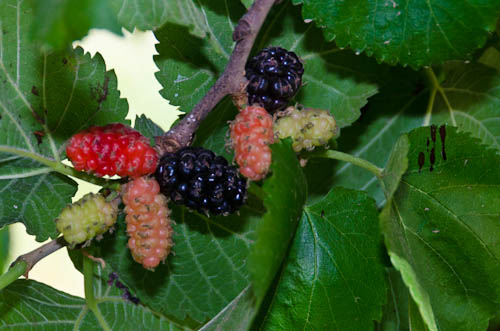
Persian Fruiting Mulberries in various stages of ripening
Persian Mulberries fruit on second year wood. How do I know that? In our budwood orchards we prune almost all of it off each winter to force new growth for budding and grafting. Even with all the new growth by summer, there is not enough fruit to take a decent photo.
This year I asked that one tree of each variety of fruiting mulberries be spared from the pruning crew so I could take photos. Last Friday, James Shao mentioned that he wanted to pick some mulberries for a fruit tasting session at a nursery on Saturday. "Not until I take photos", I replied with concern. So last Friday we found each of the unpruned trees and had a feast!
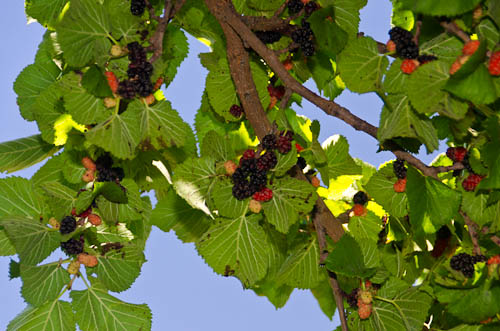
Persian Fruiting Mulberries - loaded!
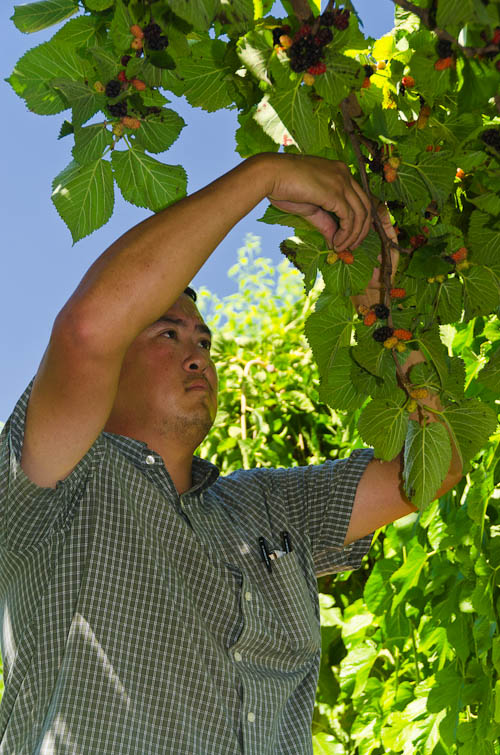
Salesman James Shao picking Persian Fruiting Mulberries
I have to admit, I have not eaten a lot of mulberries in the past for the very reason I could not photograph them. They were usually gone - what few were there were eaten either by employees or the birds. The exception was the Pakistan Fruiting Mulberries where we had the Cooke's Pakistan in testing besides the original Pakistan from years earlier. And I really liked them.
So Friday I was in for a surprise treat. After taking a number of images, it was time to do a personal taste test. Wow! These Persian Fruiting Mulberries were packed with flavor and sweetness. I clearly like them better than blackberries!
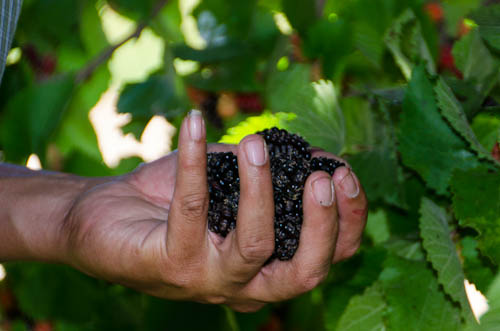
It only took a few picked berries to realize I made a mistake not bringing some paper towels to clean my fingers. They are soft and squirt juice easily and I was loath to wipe my fingers on my pants so I could handle the camera again.
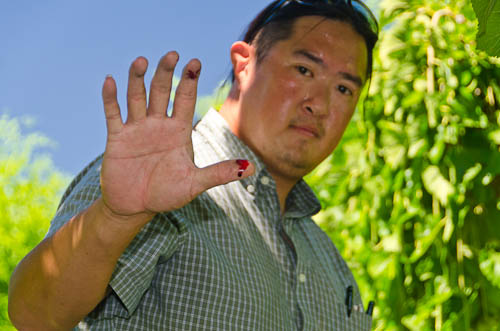
James showing Mulberry juice on his fingers - good but messy.
You have to plant a fruiting mulberry tree in the right place. They are not only messy on your fingers, but can be messy period. You have to plan for fruit drop on the ground - preferably where it does not stain concrete or other material you want to protect. Having it in an orchard or field setting is ideal or in a shrub bed. I generally try not to plant a tree in a lawn setting and this is one I clearly would keep the mess away from the lawn. Birds really love Mulberries too. Fortunately there are enough berries for you and the birds. Unfortunately, what purple fruit goes in the bird comes out purple from the other end.
The Persian Fruiting Mulberry and the Black Beauty Fruiting Mulberry are really just fast growing bushes. For years we grew them in a tree form by grafting them on top of a 5 foot "standard". In recent years, we heeded the demand to make the fruit easier to pick by lowering the tree form to a 4 foot standard and also to grow them in a bush form. You know "Ring around the Mulberry Bush" kind of form. Seems to be popular as quantities continue to increase dramatically.
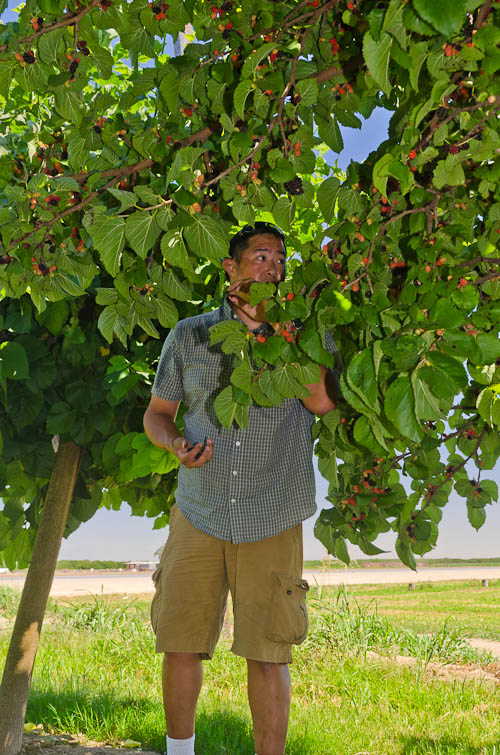
James in the Persian Mulberry Tree
Later in the orchard, we came across the Black Beauty Fruiting Mulberry. The fruit was either a week behind the Persian or the birds got all the black ones. Most were still red with very few black fruit. Looks like next week would be a better time to taste when more are ripe.
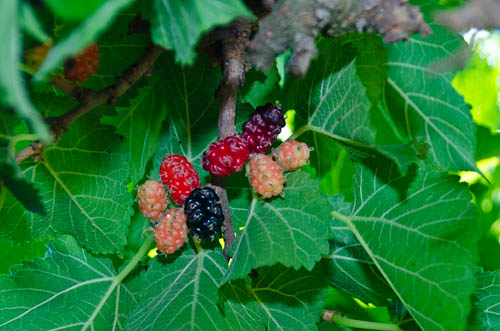
Black Beauty Fruiting Mulberry - need about another week for more to turn black.
Friday I tasted my first Black Beauty Mulberry. BAM! The flavor exploded in my mouth - one of the most enjoyable taste experiences of my life. I'll be back for more from this tree later this week.
In the wrong place, theses trees would be easy to dislike. But I cannot forget the wonderful bursts of flavor each time I ate the fruit and it seems like I am not alone as thousands of families must be finding the right places to enjoy these trees (and bushes).
More to come.
Ron Ludekens 6-27-2011
Lavender Twist® Redbud - Field Shots
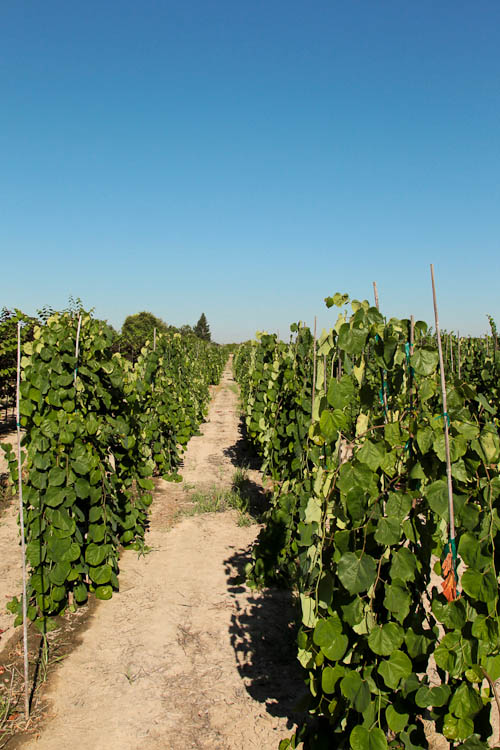
Rows of Lavender Twist® Redbuds
James Shao braved the 105 degree heat today to photograph the Lavender Twist® Redbuds (Cercis canadensis 'Covey') in our production field for one of his customers. I thought we might as well share the images with everyone else too.
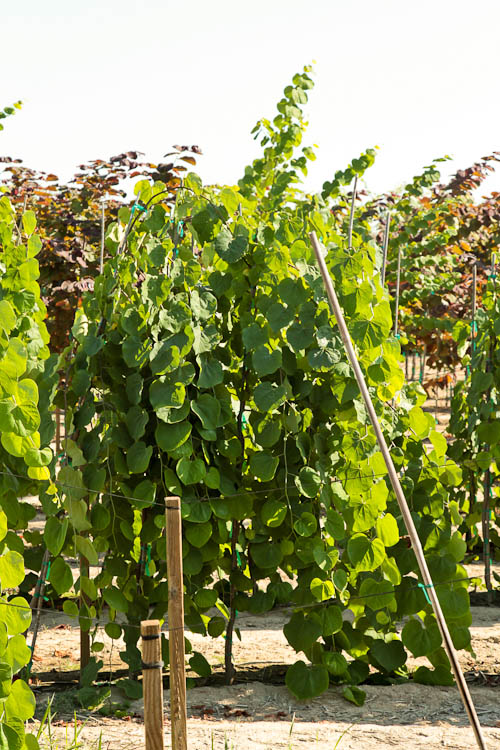
They have good size already this early in the season so harvest size should be very nice again this year.
Last fall we took some field shots when they were dormant to show their structure. That blog article is here.
Ron Ludekens 6-21-11
Bravo Lake Botanical Gardens
Last Saturday my wife and I drove to Woodlake to enjoy the Bravo Lake Botanical Gardens Berry Tasting Day. Ran into my business partner David Cox there as well. Guess we were thinking alike - great tasting fruit.
Woodlake is a small valley city of over 7,000 hard working people about 20 minutes east of us in the shadow of the Sierra Nevada Mountains. It is in the citrus belt and heavily agricultural orientated.
I believe Woodlake's population is now over 80 percent Hispanic and is not a rich town by any economic measure. But that has not stopped the population from generously making something only found in the larger and wealthier metropolitan areas of the world. They have built a wonderful Botanical Garden on an abandoned railroad right-of-way next to Bravo Lake. The volunteers are part of "Woodlake Pride" and they have been making positive, visible changes to the city and its people.

Blueberry bush showing signage - typical throughout the Gardens.
Manuel Jimenez is one of our U.C. Extension specialists in Tulare County. His research includes highly successful plantings of berries in our hot valley - especially blueberries which can thrive when the right varieties are selected and right conditions are created. Manuel is also the guiding light of the Bravo Lake Botanical Gardens.
Jewel Blueberry - One of our popular low chill selections
It has been our great pleasure to play a small part in his work at Bravo Lake. Many of the fruit trees, grapevines, berries, vegetables were donated by our nursery. The edible section of the gardens is quite extensive with much more than just what we grow. I don't think I have ever seen so many types of chillies!
One of many named chillie varieties (image taken on 2004 visit)
The goal is to show the vast amount of great food that can be grown in our climate and soils and to educate the populace about how they are grown - and taste! In more recent years the Gardens has been expanding into the ornamentals and shades.

Public finding their favorite tasting blueberries and picking some to take home.
For me, Bravo Lake Botanical Gardens is a feast for the photographers as well. Not only do I get to make images of things we grow, but also of a vast array of interesting and colorful vegetables, flowers and ornamental plants/trees. On this same day, I ran across a number of photographers (a class actually) doing bird photography.

Sample image of the many flowers on display
I think for me the most interesting observation of the day was the utter delight as people tasted the Pakistan Mulberry fruit for the first time. In between all the blueberries and blackberries set out on tables to taste, there was a station to taste the Mulberries. It clearly was the sweetest. The tree the fruit came from was only a short distance away and quite popular as people picked their own. Most had never seen or even heard of mulberries except in the childrens' rhyme.

Cooke's Pakistan Fruiting Mulberry - An new discovery and unexpected delight for the visitors.
An interesting note: over the last two years our sales of all forms of the fruiting mulberries has surpassed the sales of the non-fruiting varieites - something I would have never dreamed about in years past.

My wife, Barbara, enjoying the Cooke's Pakistan Mulberry
(she's gonna kill me for posting this)
Congratulations to Manuel and your volunteers for providing a sparkling jewel for the Valley!
More photos of Bravo Lake Botanical Garden here.
Our original plan was to stop and eat lunch as the regionally famous taqueria that sits caty-corner to the Gardens but we had to postpone that idea since we filled up on so many sweet berries.
Ron Ludekens 6-17-2011
Lorna Apricot
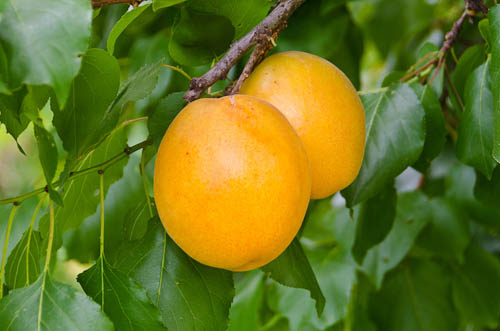
Today I drove over to the U.S.D.A. research station in Parlier to photograph the Lorna Apricot. I wanted to get good photos for our point of sale pages and picture tags, but our trees got their normal hard winter pruning (butchering) to force new vegetative growth for summer budwood. Thus no Lorna Apricots to take pictures of this year.
Craig Ledbetter - the researcher who bred this and many other Apricots - took me to the trees in their research orchards. The tree I chose to photograph (the ladder was there) was loaded:
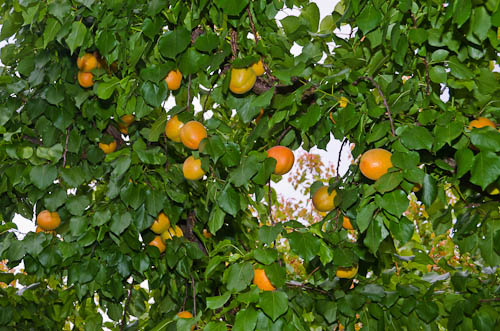
Our weather, like much of the country, has been cooler than normal. So most fruit varieties are two or more weeks behind. Normally the Lorna Apricot would be ripe in our climate around mid May. This makes it one of the earliest to fruit. It ripens just after Castlebright which is the earliest commercial apricot but Lorna is twice as large. These were impressive apricots.
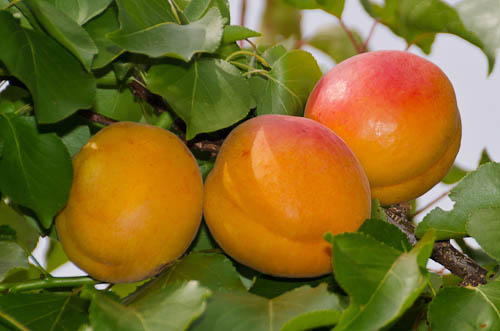
The fruit that was exposed to the sun, like those in the photo above, exhibited a nice red blush. Most of the fruit inside the foliage was an attractive yellow.
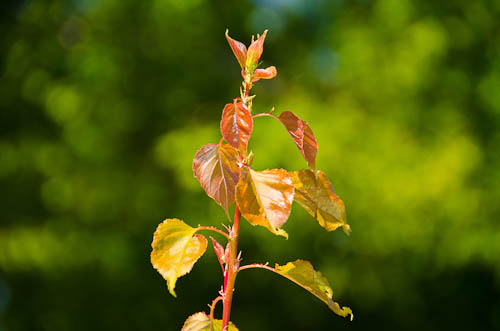
New foliage also showed a red tint before turning green.
Based upon bloom date, we are conservatively estimating 400-450 hours of chilling. I'll bet it goes lower but will have to wait for the cadres of Rare Fruit Growers and other fruit hobbyists to plant them in lower chill areas and report back on their successes. It is self fertile.
Lorna Apricot is a winner if you live in the right climate to enjoy its bountiful harvest.
Ron Ludekens 6-3-2011
Everything About Peaches
Clemson University Cooperative Extension has a website called "Everything About Peaches". It is written by Dr. Desmond R. Layne. It is full of interesting information.
I thought it was well done and worth using as a reference. Only disappointing thing is the discouragement for homeowners to grow peaches but remember, he is in South Carolina where there are humidity and bug issues tougher than most other places. Dr. Layne helps growers deal with these issues.
I would start in the Frequently Asked Questions (FAQ) section. Some topics of interest:
Do peaches need a pollinizer?
Peach Thinning
How to Pick a ripe peach
Planting a tree too deep
Why do some peaches melt in your mouth while others have a rubbery texture and some are even crunchy?
Chilling Hours
Where did Peaches come from?
Nutrient Value of a Peach
Flowering Almonds
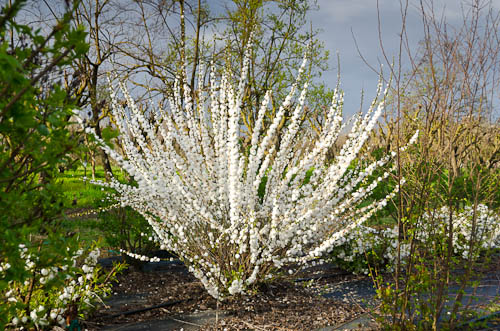
White Flowering Almond (Prunus glandulosa 'Alba Plena')
Here are some more images from my brief spring morning walk after the rains. The White Flowering Almond always catches my eye when it is in bloom. Here we have one bush left un-pruned in the row in our cutting wood orchard. A whole row (hedge) of these bushes is quite spectacular.
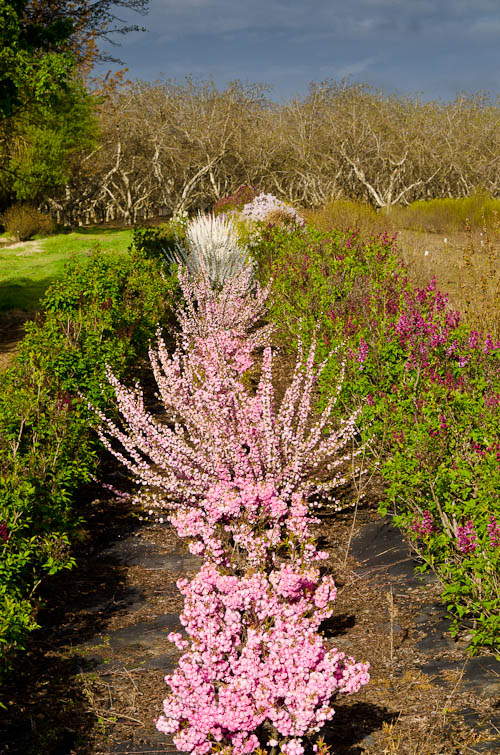
Budwood Orchard Row of Flowering Almonds
Walking a little bit east down the same row, we run into the Pink Flowering Almond (Prunus glandulosa "Rosea Plena'. They are aleady a few days past peak color - hence some faded pink already showing.
Here is a shot of the Pink Flowering Almond I took two years ago:
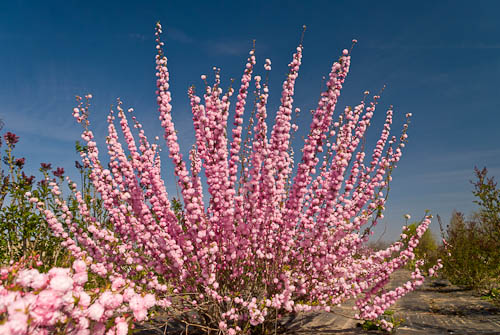
Pink Flowering Almond (Prunus glandulosa 'Rosea Plena')
We used to sell a lot of both of these plants but for some reason not as many anymore. Don't really know why - maybe Sunset Magazine needs to write a feature article on it to make it popular again. I had a pink one in my front yard for years. Bloom time was spectacular and the rest of the season it was just a nice green bush.
Ron Ludekens 4-4-2011
Spring Has Sprung
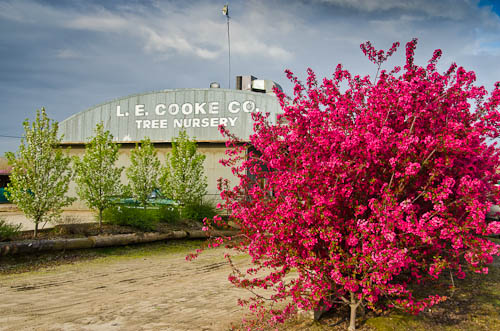
Prairifire Flowering Crabapple
On Monday I escaped the office to take a photo break. After months of harvest, shipping, new catalog preparation, sales training and copious rain, it was time to enjoy the sun and flowers. I was only out 40 minutes and shot 156 photos (52 x 3 bracketed). This is a seriously beautiful time of year in our budwood orchards. And the photographic light was special with retreating dark clouds and the sun rising under them.
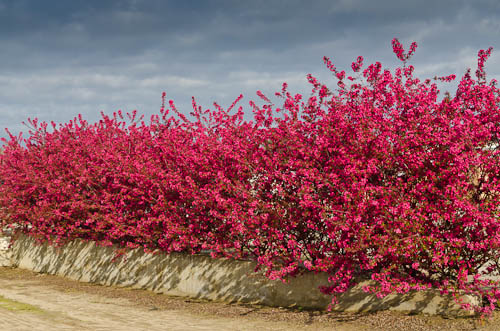
Hedge of Prairifire Flowering Crabapple
These two photos are of a hedge of Prairifire Flowering Crabapples that Phillip planted along our Supply Department shipping dock. (The Supply Department is where we manufacture the green Miracle Garden Tie used throughout the nursery industry in the U.S and Canada.) Prairifire ranks as one of my favorite Crabapples although Pink Perfection tops it in my opinion (see Pink Perfection)
More Spring photos to come.
Ron Ludekens 4-1-11
Black Beauty Mulberry Sources
Question: Looking for a retail source for the 'Black Beauty' Mulberry. Somewhere in the Bay Area? Much thanks, Nick - Ukiah, CA
Answer: Wow - second question today looking for fruiting mulberries. They are a hot commodity. Morus nigra 'Black Beauty' is a popular one both for its taste and that the tree is a smaller growing tree.
Here are some nurseries within reasonable distance from you that received Black Beauty Mulberry trees this January: Bassagnani Nursery - Sebastopol; Moraga Garden Center - Moraga; Alden Lane - Livermore; Sparetime Supply - Willits; Regan's Nursery - Fremont; Orchard Nursery & Florist - Lafayette; Adachi Nursery & Florist - El Sobronte; Calaveras Nursery - Sunol; Lumberman's/Pro-Build - Santa Cruz.
We also grow it in bush form and these nurseries may be close enough for you if you are interested: Sparetime Supply - Willits; Harmony Farm Supply & Nursery - Sebastopol; Bay Flora - Berkeley; Spiral Gardens - Berkeley; Lumberman's/Pro-Build - Santa Cruz; Far West Nurseries - Santa Cruz; McShane's Nursery - Salinas; Valley Hills Nursery - Carmel; Moon River Nursery - Albion; Fiddlers Green Nursery - Fort Bragg.
Also receiving the bush form are mail order firms Bay Laurel and Trees of Antiquity.
More information on Fruiting Mulberries here: Fruiting Mulberries
Ron Ludekens 3-1-2011





